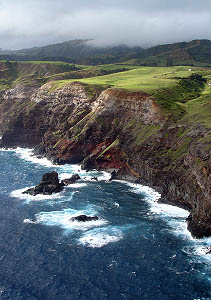I’ve been reading a lot about kava in the news lately, and I’ve noticed a trend where journalists demonize kava as a “vice.” It is true that there are many who fall into the trap of looking to kava as a panacea. Others, like myself and my family and friends, simply enjoy it was a way to relax at the end of a long day. In any case, kava is a very heady brew that one must respect and it should not be taken lightly.
Hawaii is home to the world’s finest kava, as well as to some of the world’s most gorgeous beaches, coral reefs, lagoons, lush tropical forests and mountain ranges. I often get questions about Hawaiian history, so today I’d like to give my readers a quick rundown.
We Hawaiians are essentially a verbal people, one without much recorded ancient history. We have preserved our history by way of oral histories passed down through social constructs through the ages. Much of our earliest history disappeared along with the death of numerous learned elders whose function it was to pass on this knowledge to succeeding generations through ancient chants and legends.
The modern Hawaiian history of record began when Captain James Cook’s expedition made its first contact with the Hawaiian people on the islands of Kauai and Niihau in 1778. However, Captain Cook was not the first man to “discover” the Hawaiian Islands – he was simply the first-known European to do so.
In the centuries before the arrival of Captain Cook, Hawaiian society was highly segregated with a strict caste system. Each caste had its assigned tasks and responsibilities and served its own individual function. It was not until 1810 that a single king ruled over all Hawaii. Prior to that, there was a number of small kingdoms which separated the islands. Often these separate factions were at war with each other.
In each small kingdom, that faction’s king was assisted by a chief minister and a high priest. Next in rank were chieftains whose power varied depending on their ancestral lineage and their individual abilities. Persons trained in the memorization of historical genealogies were very integral members of a chief’s inner circle, because a chief’s ranking in society was determined by the legitimacy of his genealogy. Chiefs ruled over portions of the land at the behest of the king, who could remove and replace them according to his whim of the moment.
Below the chiefs in earthly power, but often far above them in spiritual power, were the Kahuna, or priest craftsmen. They were skilled specialists in canoe-building, medicine, and spell casting and removal.
The majority of Hawaii’s people were commoners (known as makaainana), and were considered subjects of the chief upon whose land they lived. They did most of the hard work: building, fishing, farming, and textile weaving. The commoners paid taxes both to the king and their chief. Some young, strong commoner men were handed over as warriors for the chief’s army. Taxes took the form of food, clothing, servitude, as well as other products and services.
Below the commoners were a numerically small group of people known as outcastes. Not much is known of their origin or of their true role within Hawaiian society, although they were believed to be slaves of the lowest order.
Now that I have somewhat addressed the numerous inquiries I’ve received regarding Hawaii’s history – I will continue this in a subsequent blog – I want to address the questions I often receive concerning the side effects of kava.
When used intelligently and in moderation, there are no side effects to kava. The stories one reads in the media of kava causing the whites of the eyes to yellow and the skin to become yellowed, scaly and dry are describing a condition caused by kava abuse. Generally, kava abuse is centralized to economically depressed areas of the South Pacific. Many governments are taking measures to try to control this abuse through curfews and rationing.
Stories continue to permeate the media about kava causing liver damage. It is unfortunate that many journalists do not do their homework when writing stories about this. I addressed kava and liver toxicity in a blog I wrote back in July of 2008.
The media seized on a tragedy from back in the late 1990s which was the result of an unscrupulous kava manufacturer from Germany, and to this day the media repeats this rumor as fact. Recently, the European Union lifted their ban on kava, and Canada is now reviewing its ban on kava that was a reaction to this scare back in the late 1990s. I posted some recent articles about kava seizures in Australia, where it is legal to possess and sell, but not to import.
If you have any questions concerning kava, the farm, Hawaiian customs, whatever; please do not hesitate to write me. Until next time,
Aloha no,
Makaira







Good article-I understand the liver toxicity issue is because leaves and stems were extracted along with the root in making pills,etc…-Kind of like how a tomato fruit is edible,but the leaves are not-Many blessings!
Mahalo for this awa blog. We must continue to perpetuate the truth about this healing plant. Here in Hawai’i, awa is considered a sacred plant, much like noni and other medicinals that the media claims to be bad. We must always look to nature to heal us first because it is the closest thing to us.
Aloha Ke Akua.
Lady Paisley.